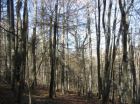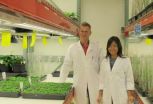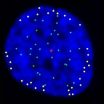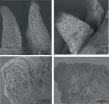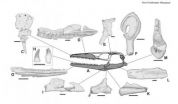A report of the Aldrich-developed procedure was recently published in the prominent peer-reviewed journal, Chemical Communications. Drs. Niraj Singh, Meenakshi Hardi and Viktor Balema from the Aldrich Hard Materials Center of Excellence demonstrated the synthesis of Y-MOF (MIL-78) using a room-temperature ball-milling process in the absence of a solvent or liquid grinding additive. In the process, yttrium hydride was ball-milled with solid high-melting trimesic acid to form Y-MOF (MIL-78). Gaseous hydrogen was the only by-product observed in the process. The liquid-free synthesis process yields MOF products of exceptional purity by preventing contamination from solvents and liquid residues.
Metal Organic Frameworks (MOFs) are an attractive class of highly ordered materials built by combining multi-functional organic molecules (linkers) and metal ions into a 3D network. The well-defined, highly-ordered, and readily-controlled structure of MOFs can be exploited in a diverse range of applications including gas storage, separations, catalysis, sensors and drug delivery. The presence of modifiable organic linkers in the MOF structure enables tunability of function and customization of end use.
Current routes to MOF materials typically rely on solution-based processes in which the organic linker and the metal source – a metal salt, carbonate or oxide – are partially or fully dissolved in an appropriate solvent and reacted. The reaction can occur in a tightly closed vessel at high temperature or by subjecting the solution to microwaves, ultrasound or electrochemical treatment. Metal-organic framework materials can also be prepared by milling solid-phase metal derivatives and solid-phase organic linkers in the presence of a liquid, which can be included as an additive with the initial solid-phase reaction mixture or generated in situ as a byproduct during the milling process. Although often asserted to be "solid-state," such processes necessarily involve liquid components, which can act as liquid micro-reactors that control the reaction process and promote the formation of MOFs by the conventional solution-based mechanism.
Until the discovery, it was uncertain whether MOF materials could be prepared in a completely liquid-free environment and whether new types of MOF materials and MOF materials of the purity required for many high-tech applications could be prepared in a cost-effective process.
"Excluding liquids from the preparation finally opens the way to making MOF materials whose properties are not influenced by the presence of contaminants and, therefore, may be quite different from those of conventional MOFs. Our approach also avoids the use of solvents, which are often harmful to the environment, difficult to remove from the extended 3D networks of the targeted MOF product materials, and detrimental to the performance of MOF materials in many applications." said Dr. Viktor Balema, Manager of the Aldrich Hard Materials Center of Excellence. Dr. Balema further noted that "Aldrich's process should enable generation of unique hybrid structures with non-conventional properties applicable in numerous areas of modern science and technology, which extend from energy generation and storage to electronics and bio-technology."
Prior to journal publication, Aldrich Materials Science filed a provisional patent application for the newly discovered procedure with the US Patent Office. "This discovery exemplifies the work being done at the Hard Materials Center of Excellence. Through this Center along with the Polymer Center of Excellence, we seek to enable innovation through new product additions to our materials portfolio, collaborations, technology licensing, custom research, process development and scale-up," commented Dr. Shashi Jasty, Director, Aldrich Materials Science.
INFORMATION:
Cautionary Statement: The foregoing release contains forward-looking statements that can be identified by terminology such as "ideally suited," "expected," "exceptional," or similar expressions, or by expressed or implied discussions regarding potential future revenues from products derived there from. You should not place undue reliance on these statements. Such forward-looking statements reflect the current views of management regarding future events, and involve known and unknown risks, uncertainties and other factors that may cause actual results to be materially different from any future results, performance or achievements expressed or implied by such statements. There can be no guarantee that new methods of preparing three-dimensional hybrid structures, in particular Metal Organic Frameworks will assist the Company to achieve any particular levels of revenue in the future. In particular, management's expectations regarding products associated with these new preparation methods could be affected by, among other things,the Company's ability to obtain or maintain patent or other proprietary intellectual property protection; competition in general; government, industry and general public pricing pressures; the impact that the foregoing factors could have on the values attributed to the Company's assets and liabilities as recorded in its consolidated balance sheet, and other risks and factors referred to in Sigma-Aldrich's current Form 10-K on file with the US Securities and Exchange Commission. Should one or more of these risks or uncertainties materialize, or should underlying assumptions prove incorrect, actual results may vary materially from those anticipated, believed, estimated or expected. Sigma-Aldrich is providing the information in this press release as of this date and does not undertake any obligation to update any forward-looking statements contained in this press release as a result of new information, future events or otherwise.
About Sigma-Aldrich: Sigma-Aldrich is a leading Life Science and High Technology company whose biochemical, organic chemical products, kits and services are used in scientific research, including genomic and proteomic research, biotechnology, pharmaceutical development, the diagnosis of disease and as key components in pharmaceutical, diagnostics and high technology manufacturing. Sigma-Aldrich customers include more than 1.3 million scientists and technologists in life science companies, university and government institutions, hospitals and industry. The Company operates in 38 countries and has nearly 9,000 employees whose objective is to provide excellent service worldwide. Sigma-Aldrich is committed to accelerating customer success through innovation and leadership in Life Science and High Technology. For more information about Sigma-Aldrich, please visit its website at www.sigma-aldrich.com.
